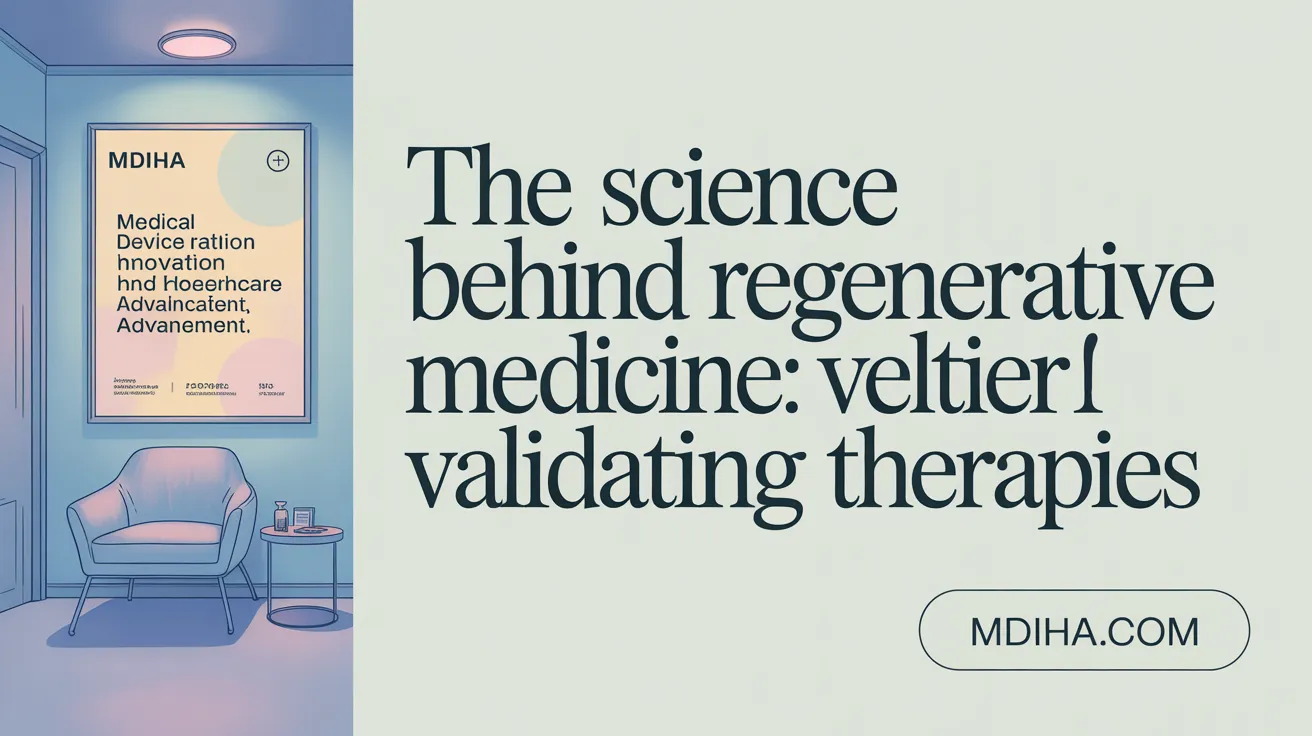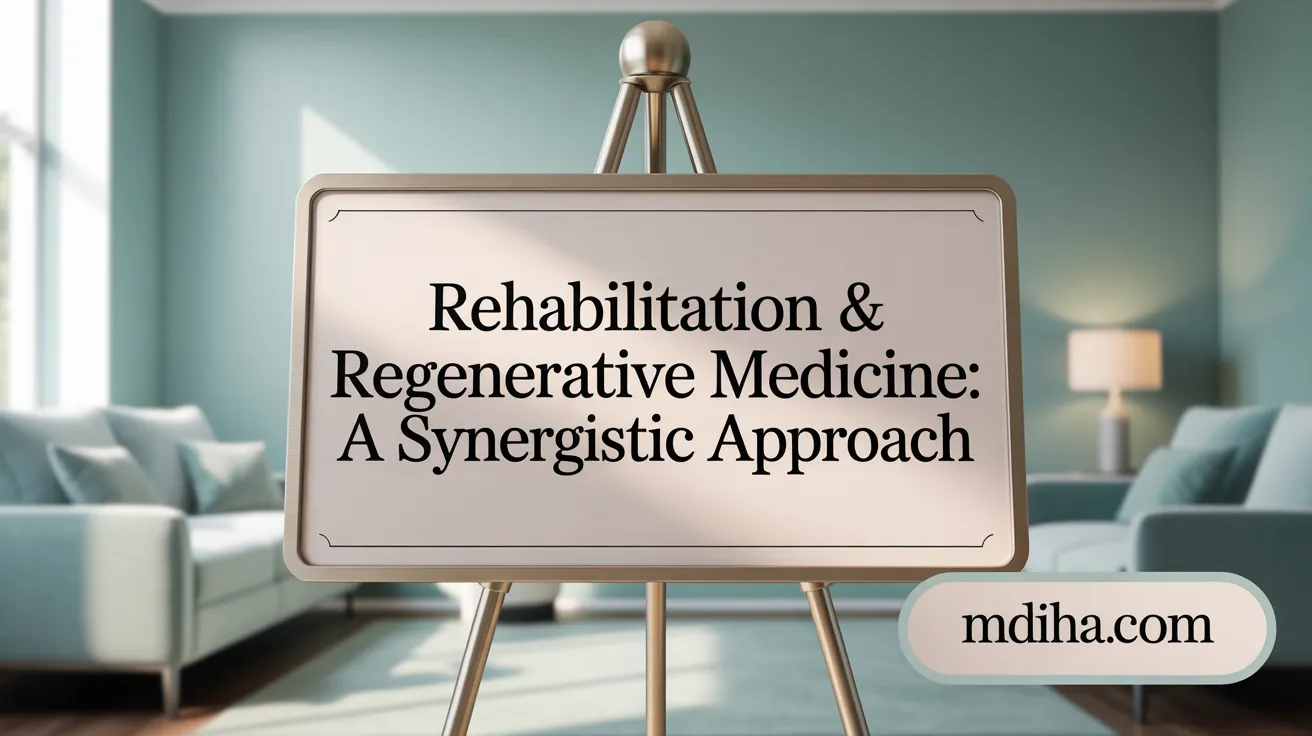Introduction to Regenerative Therapy Success Stories
Overview of regenerative therapy as a promising approach
Regenerative therapy harnesses the body's intrinsic ability to heal through advanced techniques such as stem cell injections and biologics. These interventions aim not only to alleviate symptoms but to repair damaged tissues, offering durable relief especially for chronic pain and degenerative conditions.
Highlighting patient-centered outcomes and experiences
Clinical programs like those at the Seattle Regenerative Medicine Center demonstrate significant patient improvements, with individuals regaining function and reducing reliance on invasive surgery. Patients report meaningful reductions in pain and enhanced quality of life, underscoring the real-world impact of regenerative treatments.
Setting the context within personalized longevity and health optimization
As regenerative medicine evolves, personalized approaches targeting individual biology optimize outcomes. Integrating precise diagnostics and tailored treatment plans enables sustainable healthspan extension, aligning regenerative therapies with broader goals of aging well and maintaining functional independence.
Real-Life Patient Successes: From Chronic Pain to Renewed Activity
Patient Experiences with Stem Cell Therapy for Chronic Pain
At the Seattle Regenerative Medicine Center stem cell therapy, patients suffering from chronic pain have found new hope through Stem cell therapy for chronic pain in Seattle. Using the proprietary JuvaStem proprietary stem cell process, stem cells extracted from a patient's own bone marrow are concentrated and injected into injury sites. This method not only targets inflammation but also promotes tissue regeneration, aiming for sustained relief instead of temporary symptom masking.
Specific Cases of Symptom Relief in Arthritis, Joint, and Soft Tissue Injuries
Patients with diverse conditions such as SRMC arthritis pain treatment, degenerative joint diseases, Connective tissue injury stem cell therapy, and Nerve damage stem cell therapy have reported considerable improvements. For instance, S. Lawton experienced significant relief from Pain relief from knee degeneration symptoms, enabling avoidance of invasive surgery. Similarly, Kypros G., a martial arts instructor, regained Shoulder pain stem cell therapy functionality and returned to active training post-treatment. These positive responses underline the potential of regenerative therapies in managing musculoskeletal complaints.
Avoiding Surgery Through Regenerative Treatments
By fostering the body's intrinsic healing capabilities, regenerative medicine has reduced the necessity for surgical interventions in multiple cases. D. Collins, one of the SRMC patients, noted a remarkable decrease in pain three months following the stem cell procedure and expressed willingness to undergo additional treatments for continued benefit. Such outcomes highlight how Non-surgical chronic pain treatment and personalized regenerative therapies can serve as effective alternatives to conventional surgery.
Impact of Personalized Treatment Approaches on Diverse Patient Populations
The individualized nature of stem cell therapies has attracted patients beyond the immediate locality, including Out-of-state patients choose SRMC regions like Montana. Customized treatment regimens developed through thorough evaluation ensure that patients receive optimized care tailored to their specific conditions. This personalized approach enhances efficacy and SRMC patient satisfaction across varied demographics, supporting a broader adoption of regenerative medicine in Long-term chronic pain relief Seattle management.
Patient Satisfaction and Outcomes in Personalized Regenerative Medicine

How Do Patients Rate Professionalism and Treatment Efficacy?
Patient experiences at specialized regenerative medicine centers demonstrate high satisfaction with both professionalism and treatment outcomes. For example, Seattle Regenerative Medicine Center stem cell therapy (SRMC) attracts patients from various states, including Montana, who commend the clinic's expert care and effective procedures. Martial arts instructor Kypros G.'s return to active sports and D. Collins' substantial pain relief three months post-treatment exemplify how professional delivery enhances patient confidence.
How Do Personalized Protocols Impact Treatment Success?
Personalized regenerative medicine protocols play a crucial role in maximizing treatment efficacy. Institutions like the Stem cell therapies at HSS in California prioritize individualized approaches by analyzing patient-specific cells and proteins to tailor therapies such as platelet-rich plasma (PRP) or stem cell interventions. This customization improves outcomes, particularly in conditions like osteoarthritis and post-surgical recovery.
What Are Some Examples from Regenerative Medicine Clinics?
Clinics adopt various proprietary methods to optimize repair and symptom relief. SRMC employs a proprietary process called JuvaStem proprietary stem cell process, deriving stem cells from bone marrow for precise injection into injured tissues. Mayo Clinic’s Regenerative Medicine Consult Service evaluates and administers minimally processed autologous cell therapies from bone marrow, adipose tissue, or blood, following FDA-standard protocols. These centers combine cutting-edge scientific approaches with patient-centered care.
Are Patients Open to Repeat Treatments?
Ongoing treatment willingness indicates patient trust in regenerative therapies. Patients like D. Collins express readiness to undergo repeat procedures, reflecting durable symptom relief and overall positive experiences. Given that treatments may need repeating to maintain improvement, as indicated by Mayo Clinic regenerative medicine leadership experts, patient acceptance of multiple sessions is essential for long-term management.
| Aspect | Patient Experience Example | Clinical Impact |
|---|---|---|
| Professionalism | Out-of-state patients choose SRMC | Enhances confidence and treatment adherence |
| Personalized Protocols | HSS’s cellular analysis techniques | Tailors and improves treatment outcomes |
| Treatment Techniques | JuvaStem proprietary stem cell process at SRMC | Targets inflammation and regenerates tissue |
| Willingness for Repeat Therapy | D. Collins’s planned follow-up (SRMC patient satisfaction) | Sustains long-term symptom control |
Scientific Foundations and Clinical Trials Supporting Regenerative Therapies

What does ongoing clinical research validate about regenerative treatments?
Significant ongoing clinical research at institutions like Hospital for Special Surgery (HSS) in California and Mayo Clinic in Florida provides evidence supporting evidence-based regenerative medicine therapies. These studies focus on using autologous cells—cells derived from the patient’s own body—such as bone marrow aspirate concentrate, platelet-rich plasma (PRP), and adipose-derived stromal vascular fraction. Clinical trials aim to demonstrate the safety, efficacy, and durability of these treatments for conditions including osteoarthritis, rotator cuff injuries, and osteonecrosis.
How are autologous cells sourced and utilized in these therapies?
Autologous cells are harvested using minimally invasive techniques: bone marrow or adipose tissue extraction, and blood withdrawal. These cells are then concentrated and injected into injury sites. For example, the Seattle Regenerative Medicine Center uses a proprietary process called JuvaStem that concentrates bone marrow-derived stem cells to reduce inflammation and stimulate tissue regeneration. Mayo Clinic employs similar approaches, adhering to FDA monitoring standards, ensuring regulatory compliance and patient safety.
What role does evidence-based care play in regenerative medicine?
Institutions such as Mayo Clinic emphasize evidence-based practices by evaluating patients comprehensively before recommending orthobiologic therapies. They provide transparent information about likely outcomes, including symptom relief and functional improvement rather than outright cures. This approach maintains patient trust and aligns expectations with scientific data.
Why are rigorous clinical trials critical in optimizing regenerative therapies?
Rigorous clinical trials enable characterization of the cellular mechanisms, identification of patient subgroups most likely to benefit, and refinement of dosing and delivery methods. Research at HSS and Mayo Clinic includes randomized controlled trials comparing cell therapies to placebos. These trials contribute critical data on long-term outcomes and help develop personalized regenerative protocols tailored to individual patient biology.
| Topic | Highlights | Institutional Examples |
|---|---|---|
| Clinical Validation | Efficacy in osteoarthritis, tendon repair, bone regeneration | HSS, Mayo Clinic |
| Autologous Cell Sources | Bone marrow, blood, adipose tissue | SRMC arthritis pain treatment, Mayo Clinic |
| Evidence-Based Approach | Patient evaluation, risk communication, FDA oversight | Mayo Clinic regenerative therapies |
| Trial Importance | Randomized trials, outcome measurement, protocol optimization | HSS regenerative medicine treatments, Mayo Clinic |
Integrating Regenerative Medicine with Rehabilitation: Enhancing Recovery

What is regenerative rehabilitation and what are its benefits?
Regenerative rehabilitation is an evolving interdisciplinary field that merges regenerative rehabilitation with rehabilitation practices to enhance tissue repair, restore function, and improve patient independence. By integrating cellular therapies such as stem cell therapy in regenerative medicine and biologics with rehabilitation strategies like exercise dosing, electrical stimulation, and nutritional support, it promotes optimal recovery of form and function.
How do regenerative therapies complement rehabilitation techniques?
The synergy arises as regenerative therapies initiate or accelerate tissue healing by replacing or repairing damaged cells and structures. Concurrently, rehabilitation interventions facilitate activity-mediated plasticity and functional recovery, thereby strengthening the regenerative process. For example, stem cell therapy may regenerate cartilage, while targeted exercise improves joint mobility and strength, collectively improving outcomes beyond what either could achieve alone.
What are clinical applications in post-traumatic arthritis and complex injuries?
Post-traumatic osteoarthritis (PTOA), common following articular fractures or injuries from blasts, leading to significant functional impairment, is a targeted application area. Combining regenerative approaches with rehabilitation can mitigate joint degeneration and promote recovery, restoring patients' quality of life. Complex extremity injuries, often seen in military trauma, also benefit from integrated regenerative rehabilitation methods to restore both tissue integrity and physical capabilities.
What advances are supported by federal research and veteran care programs in California?
Federal entities including the NIH regenerative medicine initiatives, VA Greater Los Angeles Healthcare System care, NSF funding for regenerative rehabilitation, and DoD regenerative medicine research invest heavily in multidisciplinary research to advance regenerative rehabilitation technologies. The VA’s Greater Los Angeles Healthcare System exemplifies practical application, delivering integrated care to veterans with traumatic injuries, utilizing regenerative therapies alongside structured rehabilitation to enhance recovery and reintegration into civilian life. Ongoing NIH-supported studies focus on molecular mechanisms of neural plasticity and tissue bioengineering to translate lab advances into clinical practice, fostering innovative, effective treatments for patients in California and beyond.
Addressing Expectations: The Balance Between Hope and Realistic Outcomes

How do patient education and evidence-based consulting shape expectations in regenerative medicine?
Patient education plays a crucial role in setting appropriate expectations for regenerative medicine therapies. Clinics such as Mayo Clinic regenerative therapies emphasize evidence-based care, providing patients with detailed explanations regarding the scope and limitations of treatments, thereby fostering informed decision-making. These consultations often include an evaluation of suitability for orthobiologic procedures, ensuring that patients understand not only the potential benefits but also the limitations inherent to these interventions.
What is the typical duration of benefit and the possibility of repeated treatments?
Regenerative therapies, including autologous cell treatments derived from blood, adipose tissue, or bone marrow, often offer pain relief and functional improvements that may last up to a year or longer. However, these outcomes are not regarded as definitive cures. As a result, patients should be prepared for the possibility that treatments might need to be repeated to maintain benefits over time. This ongoing need underscores the importance of managing expectations realistically. Research and patient outcomes in aging and orthopedics also highlight the need for long-term management strategies in Regenerative medicine treatments.
How should expectations balance improvement in function and pain relief with the absence of guaranteed cures?
While many patients experience significant reductions in chronic pain and enhancements in function—such as those treated at Seattle Regenerative Medicine Center stem cell therapy—clinicians clarify that regenerative medicine primarily aims to facilitate tissue regeneration and symptom relief rather than provide outright cures. Transparent communication about this balance is essential for ensuring patient satisfaction and adherence to therapy plans. By focusing on measurable improvements in quality of life rather than unattainable outcomes, healthcare providers maintain trust and promote optimal therapeutic engagement.
In summary, integrating thorough patient education, evidence-based regenerative medicine, and clear communication about the duration and realistic outcomes of regenerative therapies fosters a balanced perspective. This approach supports patients in navigating the promising yet complex landscape of regenerative medicine with informed optimism, aided by advances in regenerative rehabilitation and translational research.
Future Directions in Regenerative Therapy: Personalized, Proactive Health Optimization

Emerging Trends in Individualized Regenerative Treatments
Regenerative medicine is increasingly adopting personalized approaches, aiming to tailor therapies based on individual patient profiles. At institutions like Hospital for Special Surgery (HSS) in California, research integrates blood and cellular analyses during treatments to refine patient-specific strategies. This precision allows practitioners to select the most effective stem cell or biologic therapies, optimizing outcomes for musculoskeletal conditions and beyond, exemplifying advances in personalized regenerative medicine.
Expanding Applications in Orthopedics and Aging Populations
Regenerative therapies are gaining traction in orthopedics to address conditions such as osteoarthritis, degenerative disc disease, and connective tissue injuries commonly found in aging populations. Enhanced by advanced biologics like platelet-rich plasma (PRP) and stem cells derived from bone marrow or adipose tissue, these treatments offer potential to reduce inflammation, promote tissue regeneration, and improve function without surgery. This proactive intervention aligns with the goal of extending healthspan and maintaining mobility in older adults. The comprehensive understanding of platelet-rich plasma (PRP) supports its application across regenerative dermatology and orthopedics, highlighting the role of evidence-based regenerative medicine.
Research Efforts in California Contributing to Longevity Medicine
California-based centers, including HSS and the VA’s Greater Los Angeles Healthcare System, are at the forefront of integrating regenerative medicine within longevity-focused healthcare. Clinical trials are exploring stem cell applications for rotator cuff repair and post-surgical healing, with an emphasis on translating molecular and cellular research into effective therapies. Combined with rehabilitation sciences, these efforts highlight a multidisciplinary approach to prolong function and independence in chronically injured and aging individuals by emphasizing regenerative rehabilitation and the integration of regenerative medicine and rehabilitation.
Innovation in Biologics and Cell Therapies
The development of sophisticated biologics and cell therapies—such as minimally processed autologous cells and stromal vascular fraction cells—is advancing the therapeutic landscape. These innovations enhance tissue repair mechanisms and address complex injuries with greater efficacy. Institutions like the Mayo Clinic and SRMC demonstrate the successful clinical use of these therapies, providing long-term pain relief and functional recovery, with ongoing research aimed at refining protocols and developing next-generation regenerative interventions under the umbrella of evidence-based regenerative medicine.
Conclusion: Empowering Patients Through Regenerative Medicine Successes
Positive Patient Outcomes Across Regenerative Medicine
Patients at centers like the Seattle Regenerative Medicine Center and Mayo Clinic highlight significant relief from chronic pain and improved function through autologous stem cell and platelet-rich plasma treatments. These therapies have allowed individuals to avoid surgery and regain activity levels with reduced inflammation and tissue regeneration.
Transformative Role in Health Optimization
The integration of regenerative medicine with personalized diagnostics and rehabilitation approaches exemplifies a shift toward optimizing patient healthspan. This synergy improves tissue repair and functional recovery, especially for complex injuries and degenerative conditions seen in aging populations and veteran care.
Encouraging Evidence-Based Innovation
Ongoing rigorous clinical trials and multidisciplinary research underscore the importance of treatments grounded in scientific validation. Patients are encouraged to seek informed, evidence-based regenerative therapies that prioritize long-term healing and personalized care plans.
| Focus Area | Benefits | Contribution to Healthspan |
|---|---|---|
| Stem Cell Therapy | Tissue regeneration | Long-term pain relief and improved mobility |
| Platelet-Rich Plasma (PRP) | Anti-inflammatory effects | Supports healing of tendinopathies and arthritis |
| Regenerative Rehabilitation | Enhances functional recovery | Combines medicine with exercise to restore function |
| Research & Clinical Trials | Personalized treatment plans | Innovates regenerative approaches for aging patients |
